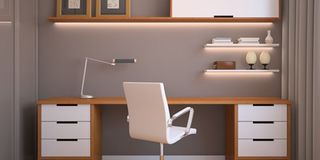Why furniture buying frenzy in Covid times

Covid-19 forced many people to work from home thus leading to a rise in demand for furniture of different kinds. PHOTOs/net
What you need to know:
The Covid-19 pandemic forced many people to set up home offices thus leading to a demand for furniture...
During the early days of the pandemic, businesses shut down, people lost jobs and many were preparing for a drop in the purchase of non-essentials. But as other businesses count losses, upscale furniture retailers and those selling home furnishings are calculating the gains of Kenyans staying and working from home.
There has been an increase in spending on home goods and furniture as people buy new sofas, cookers, and beds, paintings to breathe new life to the walls. Others are adding decorative pieces such as mirrors and potted plants to give homes a new look.
“Being indoors for a long time has brought out an element of creativity in most Kenyans. This has led to people discovering new skills such as interior design leading to renovations in their homes. This has translated into more business for us,” says Shaffi Bachoo, a director at Furniture Elegance, Nairobi.
“Customers are also looking for style and comfort. Some have realised that their living spaces now more than ever need to feel homely. Others are inclined to bring new life into their living spaces, both inside and outside,” he adds.
Shaffi says when the pandemic started, there was uncertainty as most organisations had to shift spending towards sustaining the business. Furniture is a luxury expense, says the director, meaning that most people and companies would postpone the purchase.
However, with the closure of bars and some gyms, fun is no longer outdoors. Furniture sellers are now leveraging on households or retail clients focused on creating better and fun spaces.
Working from home
In the early days of the pandemic, there was a huge increase in demand for office furniture as people looked to set up a home office for remote working. “Sale of office furniture and sofas at Furniture Elegance has gone up. Work desks, tables, chairs, and sofas are the most popular,” says Shaffi.
Agneta Kerubo-Maina says she has spent over Sh400,000 in two furniture stores, replacing items that were making her house feel dull and uninviting pre-coronavirus.
A few weeks ago, she bought another bed and beddings for Sh200,000, side cabinets for about Sh50,000, a bookshelf and curtains. She also changed her TV cabinet and got a new one at Sh60,000.
“I also bought so many potted plants and pots. They cost me about Sh20,000. I wanted to give my front-yard and outdoorsy feel with lots of beautiful plants. I got a desk and office chair because I didn’t want to keep sharing with my husband. Now I can sit outside and work without feeling confined,” she says, adding that she went over the budget but the “items are classics, they will last me decades.”
Not anticipated
The increase in furniture sales during a pandemic is not a phenomenon that home goods sellers were anticipating.
Dominic Mutua, the chief executive of Safvic Furniture Enterprises, a company in Nairobi that deals with locally-made items says the changing times in the furniture industry have thrown them a lifeline.
Most high-end furniture retailers rely on two countries for imported items. With China which produces the furniture and Italy that supplies the most high-end leather heavily affected by the coronavirus, there has been a strain in the global supply chain.
“During this pandemic, our sales have increased by 85 percent,” Dominic says.
Before Covid-19, the local furniture business was low and very competitive due to the influx of furniture imports in the market.
“The local furniture industry has been struggling as most favour imported items. This pandemic crisis has made buyers realise that locally-made products are just as good as, if not better than, the imported ones,” he adds.
The closure of bars, concert halls, movie theatres, and other non-essential businesses to try to stem the spread of the coronavirus has forced many to stay indoors, allowing many to see what kind of home they have and some are not pleased by the results.
“Most buyers say that they have no place to run to. Therefore, they have no option but to make their homes liveable and conducive. They also have a lot of time on their hands now,” says Dominic who is a lead designer at Safvic.



